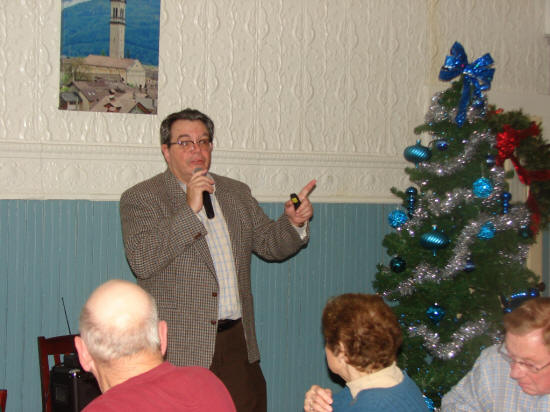|
Two 19th Century lives established
Logan County, changed Illinois and the U.S. for the better
 Send a link to a friend
Send a link to a friend
 [January 09, 2019] [January 09, 2019]
LINCOLN
Chuck McCue knows a few things about central Illinois and Logan
County in the 19th century, and the unique people who inhabited it.
That is why the Logan County Genealogical and Historical Society
invited him to address their annual holiday meeting held on November
19th at the Blue Dog Inn.
McCue’s topic was Richard J. Oglesby, a resident of central
Illinois, contemporary and friend of Abraham Lincoln.
McCue served twenty years in the Air Force, spent time in Elkhart
living on Governor Oglesby Street, volunteers at the Mount Pulaski
courthouse. He has also been involved in restoring the Daughters of
the American Revolution “Lincoln Circuit Markers Program.” The DAR
placed markers throughout central Illinois early in the 20th Century
to mark locations where Mr. Lincoln practiced law.
Chuck McCue likes to say that Richard Oglesby and Abraham Lincoln
lived parallel lives.

Like Abraham Lincoln, Richard Oglesby and his family migrated to
Illinois from Kentucky. Oglesby was born in 1824, fifteen years
after Mr. Lincoln’s birth in 1809. Even though there was an age
difference, during their political activity in Illinois later in the
19th Century, they were often referred to as “the boys from
Kentucky,” two men whose combined political savvy changed the course
of American history.
Abraham Lincoln was born into poverty. Richard Oglesby was born into
wealth and privilege.
In 1832, Abraham Lincoln lived in New Salem, and was a member and
leader in a militia unit. Richard Oglesby’s parents died in 1832,
and he came to Decatur to live with an uncle.
It is as if a magnet was drawing the two men's lives together. They
first met in 1840 when Lincoln was in the state legislature and a
lawyer. Oglesby was then sixteen years old and a junior Whig,
attending the Whig party convention, where he met Abraham Lincoln.
The Whig party was the predecessor of the Republican Party.
Earlier in his life Lincoln studied law as an apprentice. Richard
Oglesby studied law in the same manner with a mentor in Springfield.
Richard Oglesby practiced law on the Eighth Judicial Circuit in
Sullivan. Lincoln rode the entire Eighth Judicial Circuit as part of
his law practice. Their lives continued to grow closer in a parallel
track.
After a few years of legal apprenticeship, Oglesby returned to
Kentucky to attend a formal law school. He was acclaimed in his home
state, and was eventually elected Chief Justice to the Kentucky
Supreme Court.
Richard Oglesby and Abraham Lincoln parted ways in 1846. Mr. Lincoln
was then elected to the U.S. Congress, and opposed the hot button
issue of the time, the Mexican War, while Oglesby enlisted in the
military and was deployed to Mexico to fight.
Mr. Lincoln was castigated for his stance opposing the war and lost
a re-election bid in 1848. Oglesby distinguished himself in the
military at the battle of Cerro Gordo.

After the war, Abraham Lincoln rode the Eighth Judicial Circuit as a
lawyer, while Oglesby succumbed to the lure of quick riches during
the California Gold Rush.
Oglesby struck it rich in the gold fields right away. Instead of
remaining in California, Oglesby filled the need for supplies and a
dependable mail system for the 49ers by setting up a successful
general store and mail service. He became even wealthier.
Lincoln continued to ride the circuit.
Oglesby returned to Decatur in 1852 to resume his law practice. But
the wanderlust overcame him once again, and he headed off for an
extended stay touring Europe. He met heads of state and famous
Americans such as Mark Twain and Samuel Colt. His experience
observing European governments headed by royalty confirmed his
belief that America had the true answer to a fair government.
The lives of Oglesby and Lincoln really meshed during the later
years of the 1850’s.
[to top of second column] |


The Whig party no longer represented the progressive views of Lincoln and
Oglesby. They were among the first members of the newly formed Republican Party.
In the late 1850’s Lincoln’s mentor and friend David Davis wanted Mr. Lincoln to
run for President. Richard Oglesby was selected to run the Lincoln for President
effort. He took part in the Decatur State Republican Convention and then was
instrumental in the Chicago National Convention that finally nominated Mr.
Lincoln for President.
Oglesby was the marketing genius who came up with the “Railsplitter” idea to
define Mr. Lincoln as a man of the people. “It is said that Oglesby sold pieces
of the logs that Lincoln was purported to have split, more logs than Lincoln
could have split in a lifetime, to fund the campaign,” said Chuck McCue with a
laugh.
Oglesby also was elected in 1860 to a term in the Senate.
He soon resigned to enlist in the Union Army during the Civil War. He once again
distinguished himself as a brilliant military officer and strategist. When he
was wounded, his friend in the White House arranged a special train to take him
home to Illinois to recover.
Richard Oglesby was first elected Governor of Illinois in 1864.
While in office, Governor Oglesby traveled to Washington D.C. to visit with his
friend the President. On the evening of April 14, 1865, President Lincoln
invited his good friend Richard Oglesby to attend the performance of “Our
American Cousin” at Ford’s Theater with him. Oglesby had other plans for the
evening, and declined. The rest is history.
Oglesby was by the President’s side when he passed away on the morning of April
15th.
When Richard Oglesby’s first term as Illinois Governor ended, he did not seek
reelection due to the trauma of his wife’s death. He did run again in 1872 and
won. His term was short lived as he resigned to take an appointment to the U.S.
Senate.

His Senate term seemed to bore him, so he took off to the silver fields of
Colorado hoping to repeat the good fortune he had in the California Gold Rush.
It was not to be, and he returned to Illinois having lost a substantial part of
his fortune.
In 1884, he ran for governor again and won, thus making him the only man to be
Illinois governor in three non-consecutive terms.
Chuck McCue discussed Richard Oglesby’s legacy as an Illinois politician. As
governor, he worked hard to eliminate the Illinois black laws, the
discriminatory laws that made Illinois treatment of African Americans harsh and
unfair. Richard Oglesby supported the union members who fought for their rights
in the Haymarket Riot in Chicago against unfair labor laws. He remained true to
the ideals of his friend Abraham Lincoln.
Richard Oglesby died in 1899 after an accident. He was honored at his funeral
with some of the largest crowds ever seen for an Illinois leader. To add to his
stellar reputation in Illinois, his coffin was draped with the same American
flag that covered the coffin of his good friend Abraham Lincoln.
Chuck McCue concluded his discussion by reiterating that Abraham Lincoln and
Richard Oglesby, the boys from Kentucky, had a profound effect on Illinois and
the United States during their lifetimes, and on each other. Both were born in
Kentucky, both moved to Illinois, both became lawyers and served in the
military, both became successful politicians, and both were honored in their
passing. They also left their marks on central Illinois and Logan County, having
lived and worked in our neck of the woods for most of their lives.
The Logan County Genealogical and Historical Society regular monthly meetings
are on the third Monday of each month at 6:30 p.m. at the research facility
across from the Lincoln Depot. They invite interesting speakers from the area
with presentations about central Illinois history. The public is always welcome.
[Curtis Fox]

|